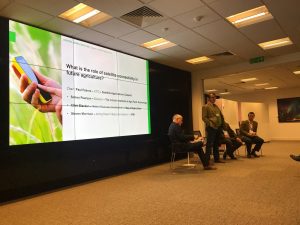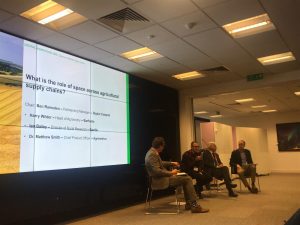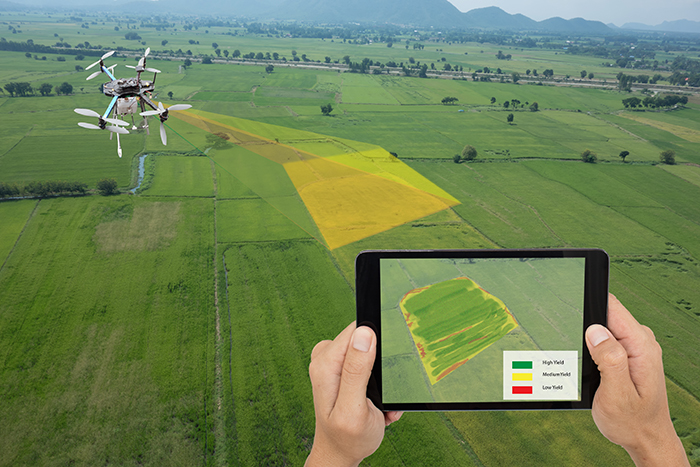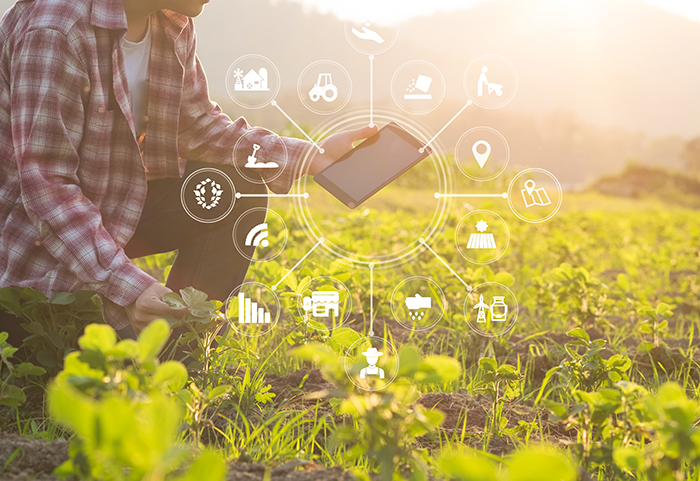Space-Enabled Agriculture
Marketing


In November 2019 the Satellite Applications Catapult hosted a ‘Space-enabled Agriculture’ event, on behalf of the Digital Agri-Food Special Interest Group. The objective of the event was to increase delegates’ understanding and awareness of the role satellite-enabled technology can have across agricultural value chains, as well as providing a networking opportunity for future collaboration between the space and agricultural sectors.
The day consisted of three panel sessions, with the first discussing the role of satellite connectivity in agriculture and was chaired by Satellite Applications Catapult CTO Paul Febvre. The panellists were Simon Pearson (Director at The Lincoln Institute of Agri-Food Tech), Clive Blacker (Head of Business Development at Map of Agriculture) and Steven Morrison (Head of Agriculture at the Agri-Food and Biosciences Institute).

The second panel session was chaired by Dan Wicks (Senior Earth Observation Specialist at the Satellite Applications Catapult) with the discussion around geospatial intelligence and its value to agriculture. The panellists were Steve Keyworth (Director at Environment Systems), David Tait (Strategic Account Director at ESRI UK) and Dave Benson (Director at MAXAR).
Lastly, the third panel session explored the challenges across agricultural supply chains and how space can help manage these problems. This session was chaired by Ben Ramsden (Partnership Manager at the Digital Catapult) and the panellists included Harry Wilder (Head of Agronomy at Barfoots), Ian Bailey (Director of Rural Research at Savills) and Dr. Matthew Smith (Chief Product Officer at Agrimetrics).

The panel sessions were followed by a ‘challenge session’ where the delegates worked together to summarise requirements from across agricultural value chains and potential solutions enabled by space technology.
This article will recap the main talking points of the day and outline some of the key challenges put forward around a changing food sector, data requirements and connecting a disparate industry.
Our global food system is facing unprecedented challenges. From population increase to climate change, demands on productivity to environmental protection – these pressures will place further strain on agricultural value chains and influence the market forces which shape food production. The current consumer trends are at odds with the globalisation of food production and, as a result, new solutions are required to address these challenges.
The panellists spoke of the struggles to access a skilled workforce, describing how the problem has worsened due to the reduction in capacity and skills offered by transient workforce. This was blamed in part on the changing patterns of immigration and the free movement of people from Europe to the UK. Issues around the availability, application and cost of pesticides were discussed too, with the increased regulatory constraints, growing demands for environmental protection and resistance to approved active ingredients forcing growers to think about alternative controls for pests and diseases. The changing subsidy landscape – a phased move from the Common Agricultural Policy (CAP) to Environmental Land Management schemes (ELMS) – provides both uncertainty and opportunity for how farmers and land managers will be paid to maintain and enhance the natural environment in future.
However, each speaker was optimistic on the role technology, including that enabled through space, can have in helping to address shortages of skilled labour, more efficient pesticide usage and the changing regulatory landscape. This technology must be adopted and exploited alongside human skills and expertise in order to meet the continuous drive to increase productivity, improve quality and reduce cost across all sectors of food production. An example of how farmers have incorporated precision technology to increase accuracy of operations is through using real-time kinematics (RTK) on tractors, enabled by global navigation satellite systems (GNSS). This is one example where satellite-enabled technology has had a broad and successful impact on farming operations at a cost effective and easy-to-access level. This locational technology is now being applied to other devices, such as autonomous vehicles working in fields or drones capturing imagery from specific co-ordinates.

One of the best-known uses of satellite technology in agricultural production and environmental protection is through earth observation satellites, a technology which was discussed throughout the event as having greater potential than is currently being used, so long as the business model stacks up. Earth observation imagery, and the subsequent analysis to extract value, is costly and individual businesses are unlikely to invest. It is currently not economical to capture a wide area of land with the aim of selling it back to farmers; the information imagery provides does not hold enough value without an array of additional, expensive, data sets.
Where imagery and monitoring products and services do have a role is across a supply chain or consortium of users – organisations who will each see a slice of value from the technology. An example of this discussed at the event was monitoring deforestation in at-risk regions of the world where forests are being destroyed in order to create farmland. There are a multitude of corporate organisations across a value chain, as well as environmental protection groups, who see value in providing their customers and shareholders with verified evidence that the products they sell from these at-risk regions have not been grown on deforested land. Achieving this requires collaboration and commitment at scale, but the underlying technology behind this initiative is earth observation and its ability to allow monitoring of land use, enable traceability of products and promote transparency across global supply chains.
Another common theme throughout the Space-enabled Agriculture event was the requirements from data to enhance decision making, empower real-time interventions and to transform operations, such as enabling autonomous vehicles and machinery.
The challenges business face around data sharing and data governance are the product of a food industry which has traditionally held siloed datasets across sectors and organisations. One proposed solution to this was to create a market where data could be traded when organisations don’t have the data they need to build new solutions. There is a need for data to be shared securely and safely, but also create commercial opportunities by making it easier for other organisations in the agricultural industry find the information they need. Robotics, artificial intelligence and ubiquitous connectivity have all been highlighted as technologies to transform food production, but they all require an ability to access and share data at ease in order to enhance the supply chains they operate within. Satellite technology can play a key role in ensuring this data is accurate, accessible and available at the frequency required by different stakeholders across the value chain.

There was strong agreement expressed by the speakers towards the need for ubiquitous availability and reliability of communications technologies or services. Rural areas, where the majority of our food is grown, is often characterised by poor connectivity – mobile network service can be inconsistent and as a result the adoption and exploitation of sensing and automated technologies is limited. There was agreement from all speakers for investment in infrastructure to allow a combination of public and private satellite-mobile networks to guarantee connectivity to farmers. This could facilitate the use of high-performance local wireless technologies in livestock sheds or on tractors to determine the in-field status of livestock or machinery.
The final message from the event was the urgent and pressing need for new and emerging technologies to support change in our food system. Digital and autonomous technologies have the potential to transform food production, processing and distribution in the UK and globally. This will only be possible if the appropriate connectivity is available at a reliable, frequent and cost-effective level. This will provide users across supply chains with the information they need to adapt to challenges and build innovative business models to ensure long-term, profitable and sustainable organisations. Space-enabled technology has a proven role as the industry moves towards a digitised food sector and addresses these challenges.
In addition to the information shared at the event and the networking opportunities, the outputs included over 60 ‘challenge statements’ and nearly 40 ‘potential solutions’ to these challenges. These requirements and ideas are forming the basis for new collaborations between stakeholders, which the Catapult is leading to shape and drive forward new projects which enable space technologies to become common place across agricultural supply chains.
Would you like to know more about how satellites can help your business? Contact agriculture@sa.catapult.org.uk to get in touch.